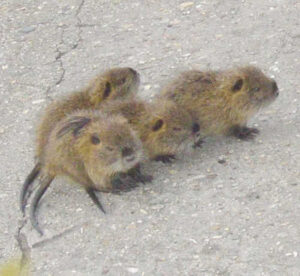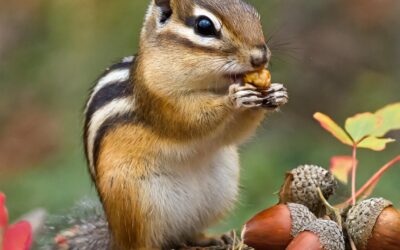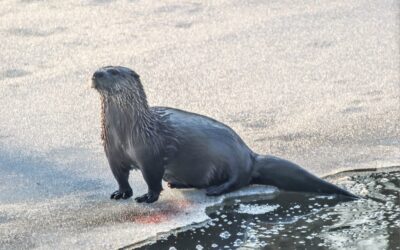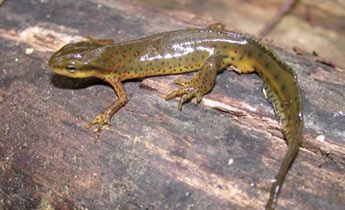The muskrat has a very honored place in Native American legends of creation. The Creator had made the sky and water, but wanted to make land, so he asked the animals to dive to the bottom of the sea and bring back some mud. The muskrat was the only one to be able to do this, and so you can thank the muskrat for the ground upon which you stand! FUN FACT: The muskrat can hold its breath for up to 17 minutes underwater – hence the legend! They can also swim backwards! Muskrats are excellent swimmers and live in marshes, wetlands, and swamps, preferring to keep 4-6 feet of water under them.
Their fur is dark brown and very dense, which helps them to stay warm and waterproofed and aids with buoyancy. The back feet are slightly webbed to help propel them through the water. The richness of the fur was exploited by the fur trade and the meat of the muskrat is still an important source of food for some communities. Their senses of sight, smell and hearing are quite limited, but they communicate with each other using squeaks and squeals and by utilizing their musky scent to mark territory or leave messages. Their whiskers are incredibly sensitive and can detect any movement under water. They are very good environmental engineers, only surpassed by the beaver. They will use banks and old burrows to build their home in, using mainly cattail foliage to build with, usually around an old tree stump. These homes will house a family group consisting of mom, dad and the kids.
They have well-defi ned territory limits, and if overcrowding becomes a problem, the mother will evict the offspring. Mating season is between March and August, during this period the family group may expand to include extended family. The female has a gestation period of about 28 days, so can produce up to 3 litters in a year ranging between 6-10 kits. The young are totally dependent for the first month of life but will reach maturity between 6 months to a year depending on where they live. Muskrats born in the northern climates tend to take longer to mature. You are most likely to see this creature at dawn or dusk and possibly in the late afternoon, but they are active for much of the day. They do not hibernate during the winter, but will continue to gather their food from under the ice. FUN FACT: To help keep warm in winter, the muskrat employs regional heterothermia. This mechanism enables the creature to use different temperature zones in various body areas. The limbs will be cooler while the vital organs will be much warmer. They are primarily vegetarians eating roots, shoots, and foliage – cattails and the yellow water lily being favorites. However, they do occasionally take a tasty frog or crayfish too. They can consume up to one third of their body weight daily. Strictly speaking, the muskrat (Ondatra zibethicus) is not a rodent but more closely aligned to voles. They can grow to be a little under 2 feet long with about 10 inches of the length being the tail. In the wild, this timid creature may live up to around 3 years of age. It has many predators including mink, fox, raccoon, bobcat, and man. Curious to know more?
ned territory limits, and if overcrowding becomes a problem, the mother will evict the offspring. Mating season is between March and August, during this period the family group may expand to include extended family. The female has a gestation period of about 28 days, so can produce up to 3 litters in a year ranging between 6-10 kits. The young are totally dependent for the first month of life but will reach maturity between 6 months to a year depending on where they live. Muskrats born in the northern climates tend to take longer to mature. You are most likely to see this creature at dawn or dusk and possibly in the late afternoon, but they are active for much of the day. They do not hibernate during the winter, but will continue to gather their food from under the ice. FUN FACT: To help keep warm in winter, the muskrat employs regional heterothermia. This mechanism enables the creature to use different temperature zones in various body areas. The limbs will be cooler while the vital organs will be much warmer. They are primarily vegetarians eating roots, shoots, and foliage – cattails and the yellow water lily being favorites. However, they do occasionally take a tasty frog or crayfish too. They can consume up to one third of their body weight daily. Strictly speaking, the muskrat (Ondatra zibethicus) is not a rodent but more closely aligned to voles. They can grow to be a little under 2 feet long with about 10 inches of the length being the tail. In the wild, this timid creature may live up to around 3 years of age. It has many predators including mink, fox, raccoon, bobcat, and man. Curious to know more?
Check out the links below for muskrat information!
https://animalcorner.org/animals/muskrat/



